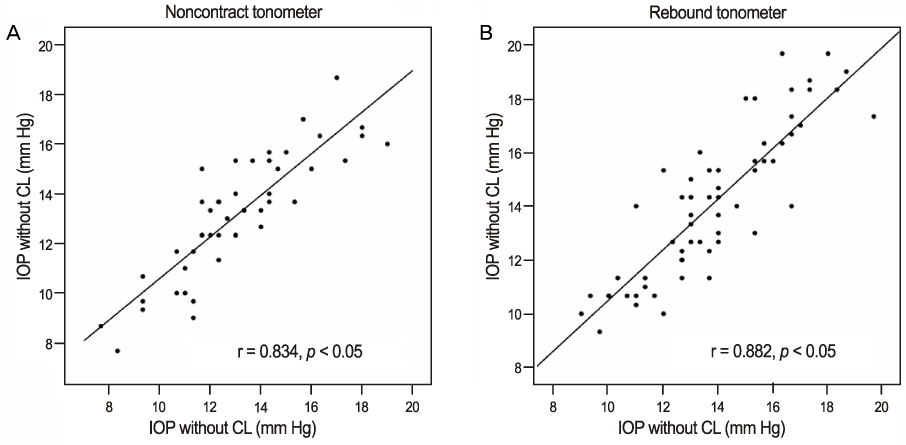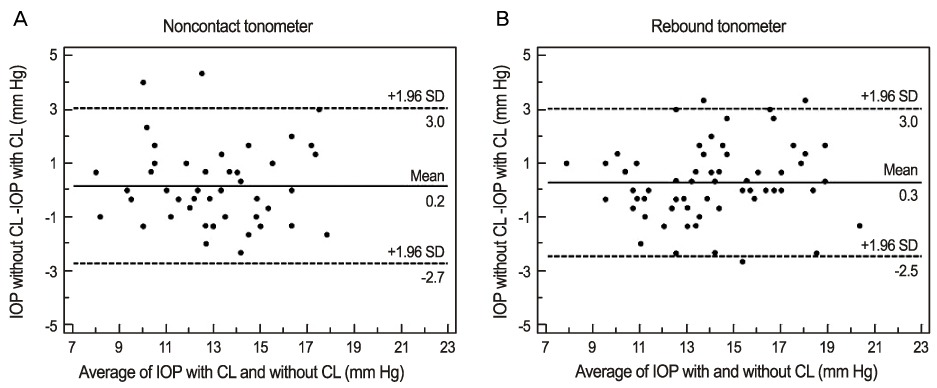J Korean Ophthalmol Soc.
2012 May;53(5):662-667.
Intraocular Pressure Measurement with the Noncontact Tonometer and Rebound Tonometer through Plano Soft Contact Lenses
- Affiliations
-
- 1Department of Ophthalmology, Kangdong Sacred Heart Hospital, Hallym University College of Medicine, Seoul, Korea. demian7435@gmail.com
Abstract
- PURPOSE
To investigate the accuracy of intraocular pressure (IOP) measurement through a plano soft contact lens (SCL) in situ by a noncontact tonometer (NCT) and a rebound tonometer (RBT).
METHODS
The IOP of 66 eyes of 33 subjects with no ocular pathology was measured by NCT (tonometer CT-80, TOPCON, Japan) and RBT (iCare rebound tonometry(TM), Tiolat Oy, Finland). IOP measurement was repeated through plano SCL (ACUVUE OASYS(R), Johnson & Johnson Vision Care Inc., USA) in situ. Statistical analysis was performed using the paired t-test.
RESULTS
Mean IOP measured by NCT was 13.10 +/- 2.52 mmHg without SCL and 12.95 +/- 2.56 mmHg with SCL. Mean IOP measured by RBT was 14.13 +/- 2.94 mmHg without SCL and 13.84 +/- 2.75 mmHg with SCL. No significant statistical differences were found between IOP measured with and without SCL (p=0.47, p=0.11 respectively).
CONCLUSIONS
Reliable measurement of IOP by NCT and RBT can be achieved through plano SCL.
Figure
Reference
-
1. Leske MC, Heijl A, Hussein M, et al. Factors for glaucoma progression and the effect of treatment: the early manifest glaucoma trial. Arch Ophthalmol. 2003. 121:48–56.2. Morrison JC, Moore CG, Deppmeier LM, et al. A rat model of chronic pressure-induced optic nerve damage. Exp Eye Res. 1997. 64:85–96.3. Henkind P, Walsh JB, Berger AW. Physicians' Desk Reference for Ophthalmology. 1986. 14th ed. Oradell, NJ: Medical Economics Company;102.4. Lee S, Kim M. Intraocular pressure difference with and without soft contact lenses by noncontact tonometry. J Korean Ophthalmol Soc. 1990. 31:415–418.5. Panek WC, Boothe WA, Lee DA, et al. Intraocular pressure measurement with the Tono-Pen through soft contact lenses. Am J Ophthalmol. 1990. 109:62–65.6. Zeri F, Lupelli L, Formichella P, et al. Goldmann applanation tonometry over daily disposable contact lens: accuracy and safety of procedure. Cont Lens Anterior Eye. 2007. 30:233–238.7. Patel S, Illahi W. Non-contact tonometry over soft contact lenses: effect of contact lens power on the measurement of intra-ocular pressure. Cont Lens Anterior Eye. 2004. 27:33–37.8. Patel S, Stevenson G. Influence of lens material and intra-ocular pressure on the outcome of non-contact tonometry over soft contact lenses. Cont Lens Anterior Eye. 2009. 32:68–72.9. Liu YC, Huang JY, Wang IJ, et al. Intraocular pressure measurement with the noncontact tonometer through soft contact lenses. J Glaucoma. 2011. 20:179–182.10. McMonnies CW. Noncontact tonometry through soft contact lenses. Am J Optom Physiol Opt. 1986. 63:948–951.11. Sugimoto-Takeuchi R, Yamamoto R, Kuwayama Y, Kinoshita S. Effect of intraocular pressure measurement through therapeutic soft contact lenses by noncontact tonometer. Nihon Ganka Gakkai Zasshi. 1991. 95:869–872.12. Insler MS, Robbins RG. Intraocular pressure by noncontact tonometry with and without soft contact lenses. Arch Ophthalmol. 1987. 105:1358–1359.13. Scibilia GD, Ehlers WH, Donshik PC. The effects of therapeutic contact lenses on intraocular pressure measurement. CLAO J. 1996. 22:262–265.14. Allen RJ, Dev Borman A, Saleh GM. Applanation tonometry in silicone hydrogel contact lens wearers. Cont Lens Anterior Eye. 2007. 30:267–269.15. Ehlers N, Hansen FK, Aasved H. Biometric correlations of corneal thickness. Acta Ophthalmol (Copenh). 1975. 53:652–659.16. Martinez-de-la-Casa JM, Garcia-Feijoo J, Vico E, et al. Effect of corneal thickness on dynamic contour, rebound, and goldmann tonometry. Ophthalmology. 2006. 113:2156–2162.17. Domke N, Hager A, Wiegand W. [Intraocular pressure and corneal thickness. A comparison between non-contact tonometry and applanation tonometry]. Ophthalmologe. 2006. 103:583–587.18. Martinez-de-la-Casa JM, Jimenez-Santos M, Saenz-Frances F, et al. Performance of the rebound, noncontact and Goldmann applanation tonometers in routine clinical practice. Acta Ophthalmol. 2011. 89:676–680.19. Nakamura M, Darhad U, Tatsumi Y, et al. Agreement of rebound tonometer in measuring intraocular pressure with three types of applanation tonometers. Am J Ophthalmol. 2006. 142:332–334.20. Kageyama M, Hirooka K, Baba T, Shiraga F. Comparison of ICare rebound tonometer with noncontact tonometer in healthy children. J Glaucoma. 2011. 20:63–66.
- Full Text Links
- Actions
-
Cited
- CITED
-
- Close
- Share
- Similar articles
-
- Intraocular Pressure Difference With and Without Soft Contact Lenses by Noncontact Tonometry
- Comparison of Intraocular Pressures According to Position Using Icare Rebound Tonometer
- Clinical Evaluation of A Noncontact Applanation Tonometer
- Comparison of the Noncontact Tonometer with Goldmann Tonometer
- Accuracy of Intraocular Pressure Measurements of Eyes with Therapeutic Contact Lenses after Vitrectomy



